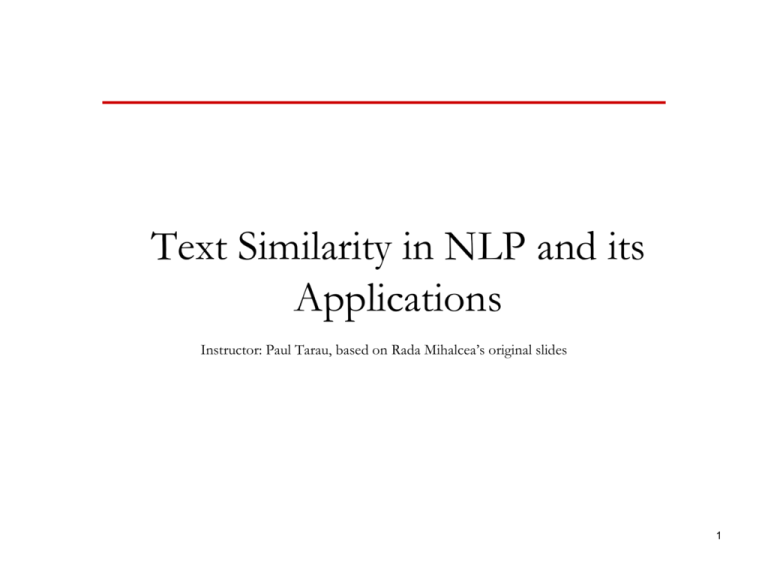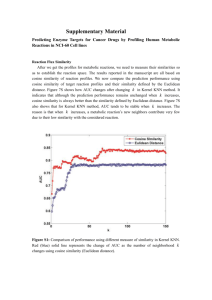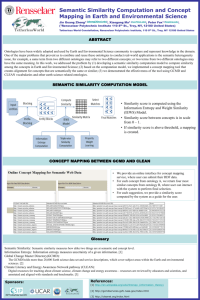13TextSimilarity
advertisement

Text Similarity in NLP and its Applications Instructor: Paul Tarau, based on Rada Mihalcea’s original slides 1 Why text similarity? Used everywhere in NLP • Information retrieval (Query vs Document) • Text classification (Document vs Category) • Word-sense disambiguation (Context vs Context) • Automatic evaluation Machine translation (Gold Standard vs Generated) Text summarization (Summary vs Original) 2 Word Similarity 3 Word Similarity • Finding similarity between words is a fundamental part of text similarity. • Words can be similar if: They mean the same thing (synonyms) They mean the opposite (antonyms) They are used in the same way (red, green) They are used in the same context (doctor, hospital, scalpel) One is a type of another (poodle, dog, mammal) • Lexical hierarchies like WordNet can be useful. 4 WordNet-like Hierarchy animal fish mammal wolf mare horse reptile dog stallion amphibian cat hunting dog dachshund terrier 5 Knowledge-based word semantic similarity • (Leacock & Chodorow, 1998) simlch log length 2* D • (Wu & Palmer, 1994) sim wup 2 * depth( LCS ) depth(concept1 ) depth(concept 2 ) • (Lesk, 1986) Finds the overlap between the dictionary entries of two words 6 Corpus-based + knowledge-based • Based on information content IC (C ) log( P(C )) P(C) = probability of seeing a concept of type C in a large corpus = probability of seeing instances ofthat concept Determine the contribution of a word sense based on the assumption of equal sense distributions: e.g. “plant” 50% occurrences are sense 1, 50% are sense 2 7 Corpus-based + knowledge-based • (Resnik, 1995) simres IC (LCS ) • (Lin, 1998) 2 * IC ( LCS ) simlin IC (concept1 ) IC (concept 2 ) • (Jiang & Conrath, 1997) sim jnc 1 IC (concept1 ) IC (concept2 ) 2 * IC ( LCS ) 8 The Vectorial Model and Cosine Similarity 9 Vectorial Similarity Model • Imagine an N-dimensional space where N is the number of unique words in a pair of texts. • Each of the two texts can be treated like a vector in this N-dimensional space. • The distance between the two vectors is an indication of the similarity of the two texts. • The cosine of the angle between the two vectors is the most common distance measure. 10 Vector space model W3 Example: T1 = 2W1 + 3W2 + 5W3 T2 = 3W1 + 7W2 + W3 cos Ɵ = T1·T2 / (|T1|*|T2| = 0.6758 T1 = 2W1 + 3W2 + 5W3 W1 T2 = 3W1 + 7W2 + W3 W2 11 Document similarity Hurricane Gilbert swept toward the Dominican Republic Sunday , and the Civil Defense alerted its heavily populated south coast to prepare for high winds, heavy rains and high seas. The storm was approaching from the southeast with sustained winds of 75 mph gusting to 92 mph . “ There is no need for alarm," Civil Defense Director Eugenio Cabral said in a television alert shortly before midnight Saturday . Cabral said residents of the province of Barahona should closely follow Gilbert 's movement . An estimated 100,000 people live in the province, including 70,000 in the city of Barahona , about 125 miles west of Santo Domingo . Tropical Storm Gilbert formed in the eastern Caribbean and strengthened into a hurricane Saturday night The National Hurricane Center in Miami reported its position at 2a.m. Sunday at latitude 16.1 north , longitude 67.5 west, about 140 miles south of Ponce, Puerto Rico, and 200 miles southeast of Santo Domingo. The National Weather Service in San Juan , Puerto Rico , said Gilbert was moving westward at 15 mph with a "broad area of cloudiness and heavy weather" rotating around the center of the storm. The weather service issued a flash flood watch for Puerto Rico and the Virgin Islands until at least 6p.m. Sunday. Strong winds associated with the Gilbert brought coastal flooding , strong southeast winds and up to 12 feet to Puerto Rico 's south coast. 12 Document Vectors for selected terms • Document1 Gilbert: 3 Hurricane: 2 Rains: 1 Storm: 2 Winds: 2 • Document2 Gilbert: 2 Hurricane: 1 Rains: 0 Storm: 1 Winds: 2 Cosine Similarity: 0.9439 13 Problems with the simple model • Common words improve the similarity too much The king is here vs The salad is cold Solution: Multiply raw counts by Inverse Document Frequency (idf) • Ignores semantic similarities I own a dog vs. I have a pet Solution: Supplement with Word Similarity 14 Problems with the simple model (cont) • Ignores syntactic relationships Mary loves John vs. John loves Mary Solution: Perform shallow SOV parsing • Ignores semantic frames/roles Yahoo bought Flickr vs. Flickr was sold to Yahoo Solution: Analyze verb classes 15 Walk-through example T1: When the defendant and his lawyer walked into the court, some of the victim supporters turned their backs to him. T2: When the defendant walked into the courthouse with his attorney, the crowd turned their backs on him. Paraphrase or not? - Compare similarity with threshold of 0.5 16 Walk-through example Te x t 1 Te x t 2 m a x S im id f d e fe n d a n t d e fe n d a n t 1 .0 3 .9 3 w a lk e d t u rn e d ba cks w a lk e d t u rn e d ba cks 1 .0 1 .0 1 .0 1 .5 8 0 .6 6 2 .4 1 T1: When the defendant and his lawyer walked into the court, some of the victim supporters turned their backs to him. T2: When the defendant walked into the courthouse with his attorney, the crowd turned their backs on him. • Vector space model Cosine similarity = 0.45 not paraphrase 17 Walk-through example Te x t 1 Te x t 2 m a x S im d e fe n d a n t d e fe n d a n t 1 .0 la w y e r a t t o rn e y 0 .9 w a lk e d w a lk e d 1 .0 c o u rt c o u rt h o u s e 0 .6 v ic t im s c o u rt h o u s e 0 .4 s u p p o rt e rsc ro w d 0 .4 t u rn e d t u rn e d 1 .0 ba cks ba cks 1 .0 id f 3 .9 3 the defendant and his 2 . 6 4 T1: When lawyer walked into the court, of the victim supporters 1 . 5 8 some turned their backs to him. 1 .0 6 the defendant walked into 2 . 1 1 T2: When the courthouse with his the crowd turned their 2 . 1 5 attorney, backs on him. 0 .6 6 2 .4 1 • Semantic similarity measure Similarity = 0.80 paraphrase 18 Pure Corpus-Based Approaches 19 Corpus-based word semantic similarity • Information exclusively derived from large corpora • (Landauer 1998) Latent semantic analysis dimensionality reduction through SVD • (Gabrilovich¸ Markovich 2007) Explicit semantic analysis uses Wikipedia concepts to define vector space 20 Latent Semantic Analysis • Finds words that co-occur within a window of a few words and forms an NxN matrix. • Mapped into k rows (k-dimensional space) using the SVD matrix operation. • This technique learns related words due to their occurrence together in a context. • Problem: Dimensions are not well defined. 21 Explicit Semantic Analysis • Determine the extent to which each word is associated with every concept of Wikipedia via term frequency or some other method. • For a text, sum up the associated concept vectors for a composite text concept vector. • Compare the texts using a standard cosine similarity or other vector similarity measure. • Advantage: The vectors can be analyzed and tweaked because they are closely tied to Wikipedia concepts. 22 ESA Example • Text1: The dog caught the red ball. • Text2: A labrador played in the park. Glossary of cue sports terms American Football Strategy Baseball Boston Red Sox T1: 2711 402 487 528 T2: 108 171 107 74 • Similarity Score: 14.38% 23 Why? • http://en.wikipedia.org/wiki/Glossary_of_cue_spo rts_terms Automatic Student Answer Grading 25 Class Grading Example Question: what is a variable? Answer: a location in memory that can store a value Grader 5 • a variable is a location in memory where a value can be stored 3.5 • a named object that can hold a numerical or letter value • it is a location in the computer 's memory where it can be stored for use by a program 5 • a variable is the memory address for a specific type of 5 stored data or from a mathematical perspective a symbol representing a fixed definition with changing values 5 • a location in memory where data can be stored and 26 retrieved Class Grading Example Question: what is a variable? Answer: a location in memory that can store a value Cosine Grader 0.724 5 0.040 3.5 0.316 5 0.106 5 0.304 5 • a variable is a location in memory where a value can be stored • a named object that can hold a numerical or letter value • it is a location in the computer 's memory where it can be stored for use by a program • a variable is the memory address for a specific type of stored data or from a mathematical perspective a symbol representing a fixed definition with changing values • a location in memory where data can be stored 27 and retrieved Class Grading Example Question: what is a variable? Answer: a location in memory that can store a value LSA-Wiki Grader 0.901 5 0.212 3.5 0.869 5 0.536 5 0.839 5 • a variable is a location in memory where a value can be stored • a named object that can hold a numerical or letter value • it is a location in the computer 's memory where it can be stored for use by a program • a variable is the memory address for a specific type of stored data or from a mathematical perspective a symbol representing a fixed definition with changing values • a location in memory where data can be stored 28 and retrieved Class Grading Example Question: what is a variable? Answer: a location in memory that can store a value ESA Grader 0.938 5 0.428 3.5 0.780 5 0.656 5 0.664 5 • a variable is a location in memory where a value can be stored • a named object that can hold a numerical or letter value • it is a location in the computer 's memory where it can be stored for use by a program • a variable is the memory address for a specific type of stored data or from a mathematical perspective a symbol representing a fixed definition with changing values • a location in memory where data can be stored 29 and retrieved Class Grading Example Question: what is a variable? Answer: a location in memory that can store a value JCN Grader 0.768 5 0.413 3.5 0.778 5 0.550 5 0.661 5 • a variable is a location in memory where a value can be stored • a named object that can hold a numerical or letter value • it is a location in the computer 's memory where it can be stored for use by a program • a variable is the memory address for a specific type of stored data or from a mathematical perspective a symbol representing a fixed definition with changing values • a location in memory where data can be stored 30 and retrieved Some Problems • Negation and Antonymy I like pizza vs I don't like pizza I ran the marathon very quickly vs I ran the marathon slowly • Semantic Role Reversal Dog bites man vs Man bites dog • Logical Inconsistency/Too Much Information It's raining today vs It's raining today because the sun is out 31







